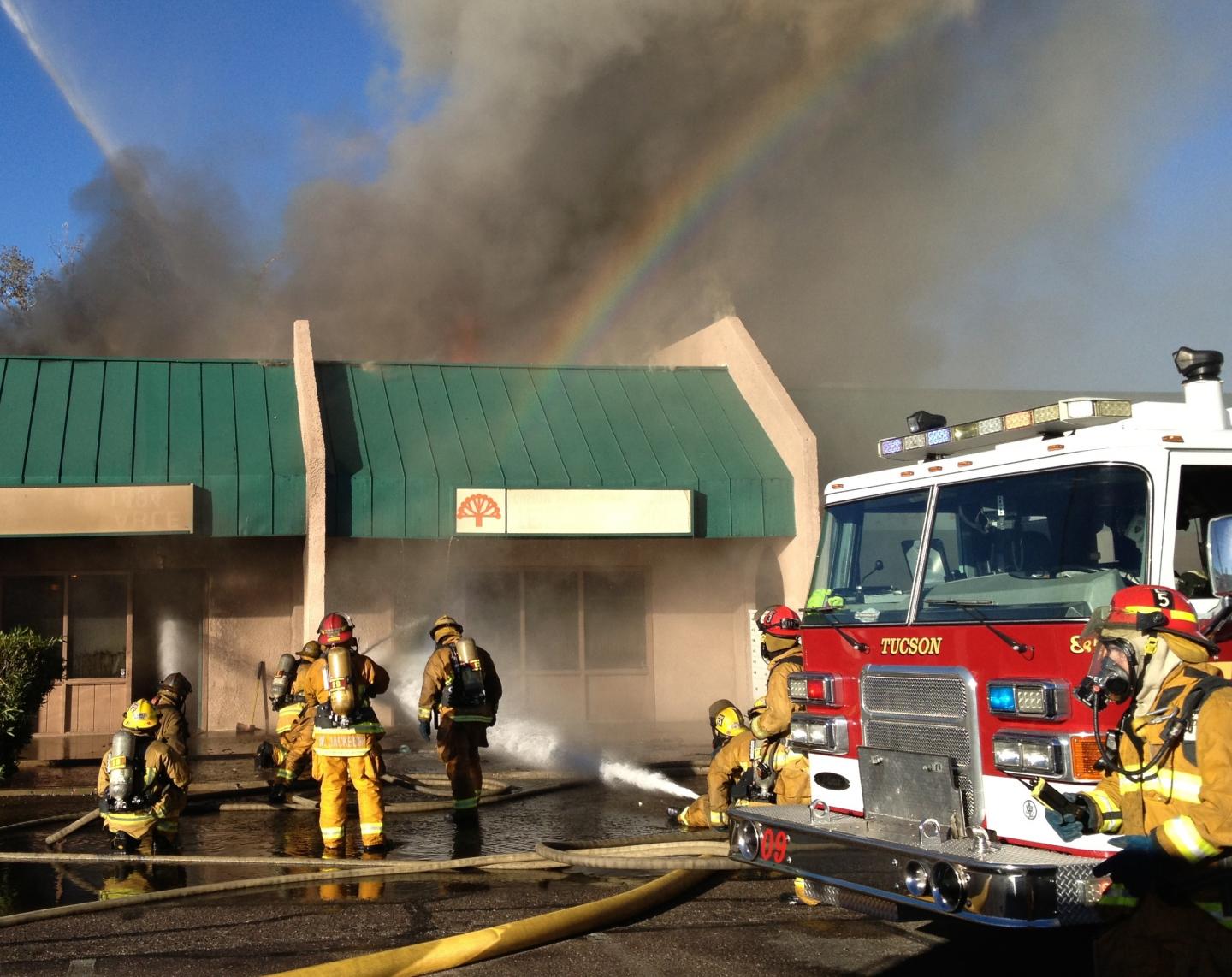
Credit: Tucson Fire Department
TUCSON, Ariz. – Researchers at the University of Arizona Mel and Enid Zuckerman College of Public Health will lead a collaborative project to develop the framework for a larger long-term study of cancer in firefighters. The $1.5 million funding for this project is from the Department of Homeland Security Federal Emergency Management Agency Assistance to Firefighters Grant.
Cancer is a leading cause of death among firefighters, who are exposed to cancer-causing chemicals through both inhalation and skin absorption. Measuring these exposures and determining the mechanisms by which they cause cancer are essential steps in learning how to reduce cancer risk in firefighters.
Firefighter exposure to carcinogens occurs through inhalation of smoke, diesel exhaust and other chemical gases, vapors and particulates as well as through skin contamination. The type of fire; the specific job task; when they put on, take off and clean their gear; and potentially how they clean their skin; all can affect the extent of chemicals absorbed internally.
Since cancer has a long latency period between exposure and the onset of disease, biomarkers also are needed that can measure the early toxicological effects of carcinogen exposure when interventions to prevent disease could be effective.
"We still don't understand which exposures are the most important and the specific cellular mechanisms by which the exposures are causing cancer. This information is necessary to determine the best ways to help prevent cancer in firefighters," said Jeff Burgess, MD, MPH, associate dean of research and professor at the UA Zuckerman College of Public Health. Improving occupational health and safety has been the focus of his research over the past 25 years, with a special focus on firefighters, other public safety personnel and miners.
"The UA Mel and Enid Zuckerman College of Public Health is committed to promoting the health of communities in our state and throughout the world," said UA President Ann Weaver Hart. "This grant will further the college's mission to achieve health equity through excellence in education, research and service and will enable tremendous impact by helping to ensure the health and safety of the men and women who dedicate their lives to serving others. This is a wonderful expression of the UA's commitment to serve our community."
"Reducing cancer risk for those who daily protect our lives and property is a priority. This landmark study will have a far-reaching impact on the health of firefighters in the United States as well as throughout the world. Not only will we gain insights into the mechanisms for the development of cancer in firefighters, the research will lead to earlier detection and treatment–and possibly to prevention–of this threat to firefighters' lives," said Joe G.N. "Skip" Garcia, MD, UA senior vice president for health sciences, the Dr. Merlin K. DuVal Professor of Medicine and an elected member of the National Academy of Medicine.
This initial three-year framework study will build on recent firefighter cancer prevention studies in Arizona and Florida, adding the Boston Fire Department and three volunteer and combination (career and volunteer) fire departments in Southern Arizona to the existing fire service partners, the Tucson Fire Department and multiple fire departments in south Florida.
"Future research grants will be needed to further expand the number of firefighters participating in the study. The goal is to continue the research for 30 or more years, which is the time it takes for many cancers to occur," said Dr. Burgess.
A cohort research study follows groups of individuals over time who are alike in many ways but differ by a certain characteristic (for example, firefighters responding to a greater number of fires over their career, compared to those with fewer responses) and compares them for a particular outcome (such as cancer). The new study also will focus on identifying epigenetic (nongenetic influences on gene expression) changes in firefighters, comparing them with a set of nonfirefighting "controls," individuals with similar age, gender, race and ethnicity. Epigenetic changes are believed to be responsible for the majority of human cancers.
"The work not only will help the fire service better understand how we are being exposed to carcinogens, it will lead to safer practices on fire incidents and improved protective equipment that ultimately will lead to fewer firefighter fatalities," said Chief Ron Siarnicki, executive director of the National Fallen Firefighters Foundation.
The Firefighter Multicenter Cancer Cohort Study: Framework Development and Testing is funded by the Department of Homeland Security Federal Emergency Management Agency Assistance to Firefighters Grant EMW-2015-FP-00213.
###
About the University of Arizona Mel and Enid Zuckerman College of Public Health
Established in 2000, the Mel and Enid Zuckerman College of Public Health at the University of Arizona Health Sciences is the first nationally accredited college of public health in the Southwest. Today the college remains the only accredited college of public health in the State of Arizona with campuses in Tucson and Phoenix. The college enrolls more than 1,100 students per year across degree programs at the bachelor, master and doctoral levels. Through research, education and community engagement, the UA Zuckerman College of Public Health continues to find solutions to public health problems in Arizona, the Southwest and globally. For more information: http://www.publichealth.arizona.edu (Follow us: Facebook | Twitter)
About the University of Arizona Health Sciences
The University of Arizona Health Sciences is the statewide leader in biomedical research and health professions training. The UA Health Sciences includes the UA Colleges of Medicine (Phoenix and Tucson), Nursing, Pharmacy and Mel and Enid Zuckerman College of Public Health, with main campus locations in Tucson and the growing Phoenix Biomedical Campus in downtown Phoenix. From these vantage points, the UA Health Sciences reaches across the state of Arizona and the greater Southwest to provide cutting-edge health education, research, patient care and community outreach services. A major economic engine, the UA Health Sciences employs almost 5,000 people, has nearly 1,000 faculty members and garners more than $126 million in research grants and contracts annually. For more information: http://uahs.arizona.edu (Follow us: Facebook | Twitter | YouTube | LinkedIn)
Media Contact
Gerri Kelly
[email protected]
520-626-9669
http://uahs.arizona.edu/
############
Story Source: Materials provided by Scienmag





